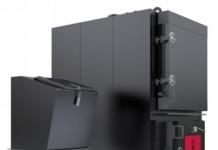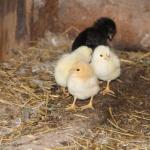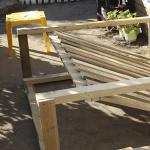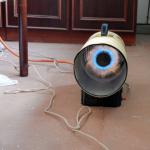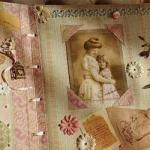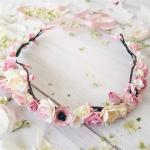Igor Nikolaev
Reading time: 5 minutes
A A
A goat feeder, despite the fact that it must comply with certain rules, is not difficult to manufacture. It can be done quite simply by hand.
It won't take long and will require a lot of effort.
However, without the right feeder, the cost of feeding goats rises significantly.
The thing is that these animals do not differ in accuracy. In the process of feeding, they often scatter food on the floor. Moreover, they categorically refuse to eat hay from the floor, and you can only throw it away. In this regard, without a properly arranged device for hay and other feeds, their consumption will be much higher than with its presence.
We will consider the most popular goat feeder designs below.
Before proceeding with the manufacture of the feeder, let's decide - what do these animals eat? Feeding goats varies depending on the conditions of their maintenance.
In summer, the main food for goats is pasture grass.
However, this does not mean that only it is enough for good nutrition. Every day, goats need:
- up to 200 grams of concentrated feed;
- up to a kilogram of root crops and vegetables;
- a small amount of dry hay (mostly in the evening, after the arrival of the herd from grazing).
In the summer, everything seems to be clear. What to feed a goat in winter?
Winter feeding of goats takes place in a round-the-clock stall, so the diet should compensate for the lack of green fodder.
An example of such a diet for feeding goats is given below:
- hay - up to 3 kg;
- grain additives - up to 1 kg;
- vegetables and root crops - up to 2 kg;
- fresh high-quality silage - up to one and a half kilograms.
In addition to feed, which is given in portions, in the stalls at all times there should be:
Feeding goats to increase their milk production should include a large amount of fresh green fodder. To have more milk, they must be provided with a sufficient amount of green mass. And if in summer there is plenty of it on pastures, then in winter the deficit to some extent compensates for silage and high-quality hay, as well as various types of mixed fodder. Compound feed for goats is produced at specialized enterprises, and buying it is not a problem.
Basic requirements for the design of a goat feeder
There are no clear criteria in domestic goat breeding on this issue. Each owner makes such feeders in his own way, based on the availability of funds and the flight of his imagination. However, whichever design you choose, it must meet certain requirements:
- Firstly, all animals should have enough space. Therefore, the length of the feeder is calculated based on the following norms for the feeding front per animal: 30 centimeters for an adult and 20 for young animals;
- secondly, the height from the edge of the feeder to the floor should not be less than one meter. This will prevent animals from jumping into it with their feet;
- thirdly, the width and height of the feeder is selected depending on the type of feed: for example, for roughage and silage, the width should be 65 cm, and the height of the sides should be 75 cm. For concentrates and root crops, these figures are 40 and 30, respectively. Above the floor, such structures are raised in accordance with the previous recommendations. However, it is still better to make a universal feeder that would fit any type of feed.
A DIY goat feeder will keep your costs to a minimum. There are quite a few options for homemade feeders. Let's dwell on the simplest and most popular:
- Old crib.
This is the simplest and most practical option for hay adaptation, because in fact it is a ready-to-use design. If someone else remembers, then such a bed is a wooden box, fenced with rods. For hay and other roughage options, this is the best option. However, the crushed root crops and compound feed will crumble, so it will be necessary to refine the structure by increasing its sides (height - see above) using plywood or fine mesh.
One of the undoubted advantages of this option is its mobility, since most often such beds have wheels. The feeder can be freely rolled around the room, and in the summer it can be taken out into the yard. For outdoor use, a rain canopy should be provided.
When using this option, do not forget about the feeding front! If you have many animals, one bed will not work.
- Homemade feeder from boards and a picket fence.
If there is no crib at hand, then the goat feeder can be made as follows: in the corner of the goat’s house we nail two boards one above the other from the bottom, and one more from the top, stepping back from the bottom ones by about 80-90 cm. These boards will serve as the frame of the future fixture (the length of the frame boards is calculated based on the norms of the feeding front and the number of animals, so if the feeders in one corner are not enough, do the same in the other); then we take the picket fence and nail it to the frame in such a way as to obtain a lattice structure. Original, practical and simple! The main condition is that the animal's head crawls between the fences.
Goats also like such feeders because they are rather thieving animals. And such a design will remind them of a neighbor's fence, because of which they will eagerly carry hay.
For this design, you need to take four wooden bars and eight thin long slats. The bars will go to the corners of the future fixture, and the slats will serve as a frame.
The result is a rectangular lattice structure in which the slats are nailed to the top and bottom of the corner bars. The free space remaining between the slats is best closed with a fine-mesh metal mesh, and either chipboard sheets or plywood are placed on top. The dimensions of the structure depend on the number and size of the animals. The disadvantages of such a feeder include the fact that goats can jump over the fence.
If each goat has its own stall, then it is better to make several such devices of small dimensions, and distribute them in front of separate pens.
Get several individual "food items".
- More fundamental option.
Feeders of this type have long been used in small European goat farms. To build such a structure, you need:
- two sheets of dense plywood or fiberboard with a height of 60 to 70 centimeters, and a width: lower edge - 60, upper - 80 cm;
- three fiberboard sheets 150 cm long and 60 cm wide;
- two wooden blocks.
Before you start assembling the structure, it is worth making a drawing of it. The sequence of work looks like this:
- with the help of nails or self-tapping screws, the bars are attached to one of the one and a half meter sheets of fiberboard. This part of the structure will play the role of the floor of the future feeder, and the bars will serve as its legs;
- to the ends of the assembled floor we nail sheets of dense plywood or fiberboard of smaller sizes. These are the side walls of the structure;
- we take the two remaining large sheets and cut rectangular windows in them so that the head of the animal passes freely through them. On each sheet of such windows should fit from six to seven pieces;
- large fiberboard sheets prepared in this way are also fastened to the floor in such a way that the windows are in their upper part;
- to strengthen the resulting structure, we additionally fasten it with metal corners.
Feed is loaded into such a feeder through the top. To prevent the goats from jumping inside, you can make a hinged lid on top or simply close the structure with a plywood sheet.
A domestic goat, that a kid, that an adult, always remains a curious and restive animal. The habit of eating grass from the upper rows, without looking at how cows do, takes root under one's feet from an early age, and it is almost impossible to change the animal's attitude to the selection of food. For pasture or meadow grazing, this style of feeding does not really matter, but in the autumn-winter period, you need to think about how to make a goat feeder, otherwise half of the hay will simply be lost and thrown onto the litter.
What gives the construction of a goat feeder
It would seem that the easiest way is not to clutter up the barn with all sorts of structures and devices, it is better to free up space for the goats, to give them the opportunity to move freely around the corral. In fact, the use of even the simplest feeders can greatly simplify the care of animals:
- If without the use of feeders for goats for hay, the irretrievable loss of feed was up to 45-50%, then after installation, eating grass and chopped vegetables was 67-69%;
- The use of a goat feeder reduces the time for issuing feed and cleaning the premises by an average of 2.5-3 times.

Important! Not all models are equally effective and convenient to use, but for the most part they allow you to get rid of the habit of animals pulling stems, hay and beets out of the tank and scattering everything, eating at best half of the food pulled out.
The greatest effect is achieved with the differentiated use of feeders and devices. For example, for a flock of goats of different ages, if adult animals are kept together with kids, a feeder with several sectors will be required so that the kids cannot jump inside the feed container and do not stain the hay and root crops. In some cases, a few kids can make a whole herd refuse food. Therefore, it is not enough to make a feed container, you need to figure out how to make a goat feeder with your own hands so that its size and shape are equally suitable for an adult animal and for a kid.
Typical designs for feeding a goat herd
Building a goat feeder with your own hands is no more difficult than for any other animals. Traditionally, frame and box structures were made of wood, but for a large herd it is more rational to make galvanized metal feeders. They are more durable and easier to maintain.
The main part of the most successful designs of feeders can be conditionally divided into several types:
- Sector feeder for mixed livestock;
- Children's options for one or two kids;
- Collapsible feeder for a large number of animals in the paddock;
- Nursery for young and adult goats;
- Troughs for crushed and chopped feed from root crops and herbs.
Each owner of a goat herd often comes up with his own feeding options, observing the habits and habits of animals. Today, even with a large herd, owners often abandon the traditional laying out of feed on the ground or low stands.
Important! The goat is rather squeamish by nature, therefore, in the pasture or in the home corral, the goat loves to pick up the tops of feed, grass, hay, as the cleanest.
Therefore, do-it-yourself goat feeders, photos, are always raised to a height of at least 35-40 cm for crushed feed, and a hay feeder for goats rises by 70-90 cm.

Sector goat feeder
The design shown in the photo allows you to feed several categories of animals at once - kids, goats and goats.

All animals differ in the size of the head, neck and height at the withers. Building goat feeders with your own hands, using photos and drawings, is not difficult, you can even improve the design by making it double-sided. Each cell or sector has its own dimensions, designed for certain sizes of the animal. Thus, the situation is excluded when some of the animals may not eat up or lose food.
For the manufacture of sectors, you will need a sheet of chipboard or OSB, pine beams, a hand saw or a jigsaw, a screwdriver and self-tapping screws from 25 to 70 mm long. First you need to assemble the frame of the feeder from a bar, the width of the compartment for food is no more than 30 cm, with wider containers, the animals simply will not reach the feed.
The front wall is stuffed from separate fragments cut from wooden planks or OSB scraps. If you wish, you can make the wall of the goat feeder with your own hands, the photo is in the form of one solid panel. One of the options for making goat feeders with your own hands is shown in the video:

In this design, feed and hay are practically not spent on bedding, which cannot be said about the next option.

Hay feeders
Hay and herbs are most of all lost when feeding animals, while goats are in no hurry to throw solid and chopped feed under their feet on the ground due to their dense consistency. The animal, as a rule, gets used to the fact that the grass must be cut off, grabbing it with its teeth and helping itself with a characteristic movement of the neck. With this method of picking up grass, goats pull out a fair amount of dry grass under their feet.
The best way to fight the wasteful habit is to have your goats eat from a tall, fenced-in trough or nursery.

For the manufacture of such a design, you will need boards and wooden slats. The pallet, transverse and side racks are knocked down from the boards. The front part of the feeder is sewn up with a rail in increments of 10-12 cm. For assembly, use short self-tapping screws. After screwing the fasteners, check if the sharp noses of the self-tapping screws of the plank have pierced right through, in which case the tip must be cut with a grinder and sanded with emery. Face planks are best made from hardwoods - oak or acacia, clean and sand the surface white, but do not cover with paint, drying oil or impregnations, as goats love to try everything out of curiosity.
The pallet only needs to be raised to a height inaccessible to the kids. For them, you can make your own feeders with a small distance between the slats. In this case, for each group of animals it will be possible to make their own diet and their own set of feeds.
In the photo below you can see how to make a goat nursery feeder from a netting. The easiest way is to sew up the feeder with a steel mesh, the small size of the cell will not allow the goats to pull out the hay on the floor.

Nurseries and trellis structures can be used to feed goats on the run and pasture, when there is not enough pasture grass, or the owners want to protect the lawn, the adjacent territory from trampling and eating by curious animals.
Hay in such feeders does not rot or become damp due to ventilation with air currents, and the large volume of the grass hopper makes it possible to load feed once a day.
Feeder options for goats with kids
For young animals, you can make a box for bait with chopped and granulated feed. The box can be made of plywood or OSB, sew up the front plane with a mesh, and close the back with a sheet of plexiglass or transparent polycarbonate. This will make it possible to control the amount of feed in the box. To load the feed, the top cover is mounted on rubber hinges, the glass can be made removable for easy cleaning and cleaning of the feeder.

For growing goats and young animals kept separately from the herd, personal feeders are often made from plastic barrels, photo.

From one 50-liter plastic barrel, you can make two feeders at once. To do this, the barrel is cut in a zigzag, the edges are carefully cleaned and reinforced on a foundation of a pair of cinder blocks. The internal space of the feeder is divided by a wire mesh of soft, annealed six-millimeter wire rod. A single portion of hay per goat is placed in the feed compartment, while the dimensions of the barrel allow several animals to use the feeder at the same time.
In the bottom part, a hole is necessarily cut out for garbage collection and removal of water after washing, since young goats and kids, despite all the tricks, still climb with their front legs onto the stand. Plastic can be considered the most convenient for the construction of various types of containers for storing and distributing feed. Light weight allows you to take the feeders to the corral, grazing or just leave it in the rain, especially without fear of getting the material wet. Goats, who love to taste everything, usually bypass plastic because of the pungent smell of PVC.
To feed young goats and kids in a paddock, you can build a bird feeder.

For manufacturing, you can use planks and trimmings of wooden pallets. The first step is to build the base of the feeder. The stand can be cut out of plywood, but it is best to use a regular lining or edged board, 20 mm thick. The slats are sewn together by stuffing a pair of bars, the legs are nailed and the stand is supplemented with a small rim so that part of the grass is not dropped by the goat onto the ground. A feed hopper is installed in the central part of the feeder. It can be made from a barrel, an old tank, or assembled from OSB scraps on self-tapping screws.
Feed dispensers do not have to be made of wood or plastic, if you are breeding goats on a more or less permanent basis, it makes sense to build a metal cone-type feeder.

A relatively simple scheme of two steel sheets welded with a wedge. The feed hopper is mounted on an angle steel frame. Legs and an axle for removable wheels are welded to the pallet. This design can be used for hay or mixed chopped feed. The metal surface allows the dispenser to be washed with a pressure washer, steamed and disinfected in the event of a visit from mice, rats or an animal outbreak.
Row feeders for pens and stalls
Feeding three or four goats is not difficult, and one or two relatively small structures can be dispensed with. It's another matter if you have to feed a whole herd.

For example, for dairy goats kept in a stall, evening or morning feeding is easiest to organize using folding senniks.


The feeder is ideal for a small herd of goats and can be filled with hay or grass in minutes. Thanks to the hinged design, you can enter the pen and clean out without having to remove or drag the floor boxes for food. Through the trays in the lower part of the structure, you can add chopped root crops and mixed fodder top dressing.
The double-sided version of the feeder can be installed in the summer goat feeder in the spring.

Conclusion
Building a feeder is not much of a problem for someone familiar with joinery or carpentry. There are always boards, wooden beams and slats on the farm, from which you can build a very simple, convenient feeder. Even in the case when there is a herd of goats that is significant in number, or for a dairy farm, building feeders with your own hands from a bar will cost much less than purchased branded options.
A completely different situation occurs in winter, when goats begin the stall period. Here it is necessary to equip each pen with individual feeders, which often leads to unplanned difficulties. Goats with a controversial character will not pick up hay from the floor, but from the feeder they will eat it perfectly.
In fact, the wrong design of the nursery and their installation in an inconvenient place will lead to the fact that the animals will simply throw all the food on the floor and refuse it. To avoid such situations, the owner must approach the installation of the nursery in the most responsible way.
What is the need
Goats are among those animals from which dairy products are obtained, which are in great demand among consumers. If we talk about the content, then small ruminants (SRC) require a much smaller amount of cash compared to cows. But in order to get enough milk, the livestock must be provided not only with high-quality food, but also with convenient feeders.
The nursery is made in such a way as to minimize contact with animals. This will greatly reduce the cost of human labor. Hay laying is best done from the side of the corridor.
What are the requirements for any feed containers
The most important criterion is the safety for the animal. In order to comply with it, the farmer, when choosing a design and carrying out installation, must take care of the following parameters:
- the size of the feed cell should allow the goat to freely stick its head to the very end of the feeder and at the same time not come into contact with the wall. The dimensions should exclude the possibility of the animal climbing inside, as well as getting the limbs into the feeder;
- to avoid problems with sticking, there must be at least 3 cm between the straps and the neck. To calculate the height, individual measurements of animals are carried out. Particular attention is paid to horned individuals: their horns should not cling to or get stuck in the feeder;
- in the presence of kids, it is recommended to make a slot under the feed in the form of a keyhole. The young will eat from the bottom and the adults from the top;
- special attention is paid to the protective coating: it should not pose a danger to goats and be toxic;
- feed should not fall on the bedding, be contaminated, mixed with water or animal feces;
- containers for feed are set in such a way that the animals eat, lined up in a row. It is not worth installing feeders in front of the entrance, this will make it difficult for the goats to move. The best place will be the opposite wall.
Summing up, we can say the following: any feeders should be safe and convenient, as well as ensure food is eaten without loss of food.
Typical designs
Making your own feeder is not as difficult as it seems. As for the traditional options in the form of boxes with frames, wood is used for their manufacture. However, with a large number of livestock, a galvanized metal container is most suitable. Such structures are durable and easy to maintain.

The most successful options for feeders have some divisions:
- sector type with mixed livestock;
- feeder for young animals for one or two heads;
- collapsible structures with a large number of individuals contained in one pen;
- hay feeders for kids and adults;
- containers for crushed grain and chopped vegetables.
It is worth considering all these types in more detail.
Sector option
Before making such a feeder, it is necessary to measure the animals on the head, neck and withers. Some owners make designs double-sided. Here, each sector has an individual size, designed for a particular goat. This option eliminates malnutrition and feed wastage.
To make such a feeder, you need:
- sheet chipboard;
- main bars;
- hand saw;
- electric jigsaw;
- several screws;
- screwdriver
For the manufacture of the front wall, separate fragments are used, which are cut from wooden planks.

hay nursery
Very often, the biggest losses of both hay and green mass occur due to the throwing of these types of feed on the floor. However, this is not harmful to animals. In nature, goats grab grass with their teeth, make a characteristic movement with their neck and cut it off. This instinct has not gone away, and, trying to get their own food, the animals involuntarily throw dry grass out of the feeders onto the floor.
A high fence on a nursery or hay trough avoids this.
To make a similar version of the device for hay, you need to stock up on boards and slats made of wood. The boards go to the manufacture of the pallet and side racks. The front part of the manger must be sewn up with a rail. To assemble the structure, short self-tapping screws are used. After the fasteners are wrapped, it is necessary to check the integrity of the feeder. The sharp part of the self-tapping screw can break through the slats. In this case, the point must be trimmed and polished to avoid injury to the animals.
It is recommended to use solid wood for faceplates in order to increase the service life. It is better not to paint or impregnate such a surface. Goats are very fond of nibbling on wooden structures, and such materials can cause animal poisoning.
The pallets of this part of the structure should be located out of reach of the young. The kids are given individual feeders, where there is a small distance between the slats. This option allows each group of goats to be fed a separate diet.
Feeders used in corrals and row-type stalls
In order for several animals to have enough food, one small feeder is enough. It is a completely different matter - feeding several dozen individuals.
Dairy goats for vespers and morning distribution of hay are best made with a folding sennik. This option is ideal for several animals. Filling is very fast. The hinged design allows you to easily enter the stall and clean the room without pulling out the floor nursery. The lower part is adapted for cut root crops and mixed fodder.
Double-sided type is installed in summer pens for additional feeding of animals.

What to feed queens with young
Young animals will need containers for chopped vegetables and animal feed. In this case, a box-shaped design is suitable, for the manufacture of which plywood and fine mesh are used. The front must be lined with mesh, and the back wall must be made of plexiglass. The transparency of the material allows you to control the amount of food in the feeder. The upper part is made as a cover with rubber loops.

Growing goats, already separated from their mothers, are made feeders using plastic barrels with a capacity of 50 liters, which is enough for two designs.
To make a feeder from a plastic barrel, it is necessary to make a zigzag cut, after which it is good to clean the edges and fix it on a solid foundation. From the inside, a wire mesh is used to divide into departments, which should be soft. In this feeder you can put a portion of hay or grass, designed for one time. And due to the size of the barrel, several animals can use it at once.
The bottom of the frame should have a cut out hole so that you can remove the remnants of food and remove water after the container has been washed. Only plastic products have a number of advantages over others, namely:
- due to its light weight, the feeder can be installed anywhere;
- the water resistance of the material allows you to leave the barrel under the rain;
- the pungent smell of plastic deters goats from chewing through the edges of the manger.
Making feeders with your own hands allows the farmer to save a lot of money, because a very significant amount will have to be paid for factory work.
Compliance with safety is the main requirement in the manufacture of feeders. You need to think about how to do it right so that the goats do not get injured:
- animals should not climb into the feeders;
- there should be no protruding rods, nails or other parts capable of causing injury;
- goats can get stuck;
- paints and other coatings must be safe.
The simpler the design of the feeder, the better. This rule must be taken into account both during construction and future operation. You can make a feeder from any materials at hand - boards, old barrels, metal pipes. But you should consider what type of food you will be using. If you have a large livestock, then it is advisable to use feeders for good volumes - rolls of 400-600 kg. For their laying, special loaders are used. In the corrals, special cylindrical feeders are installed to fit the size of the roll; the process of giving feed for a huge livestock takes minutes.
In a small farm, it is better to use bales of 20-30 kg or loose hay. In this case, any type of hanging feeders or standing bunker feeders will suit you. It is important to remove ropes when using baled feed, as goats often eat them, leading to blockages..
The wrong type of feeder will not allow you to save on feed. If a trough is not placed under the manger, then there will be a great loss of hay and branches that are trampled on by animals and mixed with manure. Also, mixed fodder, root crops, mixers, grain are put into this trough. That allows you to save on space and the number of feeders.
Any type of feeder should have a fence of poles. The gap between them allows the goat to stick its head in to take food, but prevents the penetration of the animal itself. If kids are kept together with milking animals, then the slots should be of different widths - windows are made with an interval of 20 cm at a height of 60 cm from the floor, and a 10 cm slot falls below. head into the window, and then lowers it lower.
How to make feeders yourself - simple schemes
When choosing a feeder, you need to take into account the area of \u200b\u200bthe barn, your livestock, the availability of materials, and financial capabilities. Also keep in mind that you may have to expand (the number of goats will increase), then you will have to redo the structure. Equally important is maintainability - the animals will not wait until you can fix the feeder, which will lead to injuries and a drop in productivity.
In the goat's house, it is necessary to have feeders of all types: for hay, concentrates, succulent feed.
Hanging nurseries and other simple structures
This is the simplest and most common model for placing hay and other roughage (scrap, brooms). Such feeders are attached to the wall, partitions, gates. This allows you to save materials (half of the structure is already available), as well as the area of \u200b\u200bthe room.
Corner option for 1-3 goats:
- in the corner of the corral at a height of 20 cm from the floor, a beam with a section of 50 mm or a board 100 mm wide and 30-40 mm thick is attached. Bar length - 40 cm;
- at a height of 100 cm from the floor, another beam is attached, parallel to the ground, but 80 cm long;
- we sew the bars together with slats (bars with a cross section of 20-25 mm) with intervals on the lower one of 10-12 cm, and on the upper one - 20-25 cm.
This design makes it easy to lay hay, and goats take it in small bunches. The crate prevents the goat from crawling into the feeder and contaminating the food. Narrow gaps below interfere with the kids. 
Other simple models of feeders:
- a chain-link mesh fixed on the wall with cells of 5-7 cm;
- plastic barrel with windows 20x20 cm;
- window frames attached to each other.
The main disadvantage of all the feeders described above is a large loss of feed. Small blades of grass fall out and are trampled by goats, mixed with feces and bedding. Animals don't eat that kind of food anymore. In addition, there are other disadvantages - a plastic barrel needs to be additionally fixed, the net rubs the muzzle of goats, and the corner feeder has a small capacity and is only suitable for small livestock.
Do-it-yourself wall and street combined goat feeder
If you decide to do goat breeding thoroughly, then you need to approach feeding especially responsibly. Feed is a big waste of money - up to 50% or more of the annual budget. Excessive loss of feed due to the wrong design of the feeder further reduces the profitability.
 It is better to place the feeder along the aisle so that it is convenient for you to give food to the goats and conduct an inspection, and also once again not to frighten the animals by going into their pen. For its manufacture, you can use both wood (it is more accessible, easier to process), and metal (more durable, easier to maintain). The choice of material does not affect the type of construction, so the scheme of the feeder from the boards will be described:
It is better to place the feeder along the aisle so that it is convenient for you to give food to the goats and conduct an inspection, and also once again not to frighten the animals by going into their pen. For its manufacture, you can use both wood (it is more accessible, easier to process), and metal (more durable, easier to maintain). The choice of material does not affect the type of construction, so the scheme of the feeder from the boards will be described:
- height from the floor - 150 cm;
- length - 30 cm + 15 cm for each head;
- depth - at the bottom 20 cm, at the top - 50-60 cm;
- the gaps between the rods are 10-15 cm for dairy goats.
A full-length tray or trough must be placed under the feeder. This is necessary to reduce the loss of feed - the grass will be collected in the trough, and then eaten by the goats. It is also possible to give such waste to a goat or other cattle that is less demanding on food. If you plan to give mash and other wet food (silage, chopped root crops) in a separate feeder, then you can make a wooden pallet. If you have a universal feeder (concentrates, coarse and juicy feeds are put into the pan), then it is better to make it from metal or thick plastic. Such materials are easier to clean - food particles collect in the cracks between the boards, which leads to their decay.
 Attention should be paid to the rods and the gaps between them. If your dairy goats are kept separately from the rest of the livestock, then a slot width of 15-20 cm is suitable for them. But when adults and young animals are bred together, this design is not suitable - a goat will only stick its head into such slots, but a goat can climb entirely . In this case, they act differently - the gaps are made of different sizes at different heights. As rods, slats 20 cm wide are used, they are installed with a gap of 10 cm. In the upper part (100 cm from the floor), the gap expands to 20 cm (part of the board is cut down). It turns out that a goat can stick its head in there and lower its neck along the slot, but a goat cannot crawl through in the lower part.
Attention should be paid to the rods and the gaps between them. If your dairy goats are kept separately from the rest of the livestock, then a slot width of 15-20 cm is suitable for them. But when adults and young animals are bred together, this design is not suitable - a goat will only stick its head into such slots, but a goat can climb entirely . In this case, they act differently - the gaps are made of different sizes at different heights. As rods, slats 20 cm wide are used, they are installed with a gap of 10 cm. In the upper part (100 cm from the floor), the gap expands to 20 cm (part of the board is cut down). It turns out that a goat can stick its head in there and lower its neck along the slot, but a goat cannot crawl through in the lower part.
In winter, goats must be released into the corral - a fenced area next to the shed for insolation and active exercise. On the territory of the enclosure, you also need to put a feeder for roughage. Its design is identical to the wall one, only the goats should have access to hay from two sides. It is also better to build a roof - to protect against precipitation.
Excellent do-it-yourself outdoor goat feeders are made from plastic barrels. They are suitable for any animal, but are more often used for young animals. You will need a 100 liter barrel. We make diametrical symmetrical marks at both ends of the barrel. Now we retreat from them by 20 cm and mark out half the circle from above and below. Now we need to cut the barrel to make two identical parts. Each of which has a bottom and a side wall.
Now you need to put the grate on the central part of the barrel in the entire resulting height. A masonry mesh with a cell of 100 mm is perfect. We put hay in the resulting bunker from a half-barrel and a net. The kids will get food through the cells, and eat up the leftovers from the pan. The disadvantage of this design is lightness, adult animals can easily move. There is also no roof - so it is better to put it under a canopy.
Why do goats need feeders?
Many types of domestic animals are simply given simple troughs or basins for food and hay. But it is believed that goats are in dire need of feeders. Why?

Check also these articles

Feeders for goats, depending on the material from which they are made and the purpose, there are several varieties.

As for the difference in age, adult and young goat feeders are usually not made separately. It is expensive, and additional construction will take up space. In order for the young to also reach the hay, additional holes are made at the level of their necks or they simply hang the feeder a little lower.
What should be a goat feeder?
Before proceeding to the detailed instructions for making goat feeders, you need to figure out what the design should be like so that the goats are comfortable and the breeder does not spend extra money.

How to make a hay feeder with your own hands?

Goat feeders for hay are not difficult to make. It will take no more than 3 hours and all the necessary material.

For compound feed and mash, it is necessary to make a feeder that will not break, will have an easy approach for goats and kids, and will be able to reliably protect the feed from dirt.

The easiest option is to take a thick pipe with a diameter of 11 cm or more, and a length of about 1.5 meters, made of metal or plastic. On the one hand, it should be curved. Now the pipe is turned over so that the curved side is at the bottom, at the level of the goat's head and attached to the wall. Fasteners must be such that the pipe can be removed and washed. A cover is made of metal or any other material on top, otherwise insects, dust, dirt, or even rodents will get inside. Everything, the goat feeder is ready. When the food falls asleep, it will fall into the curved part, but not on the floor, and the goats will be able to eat it.
For mixers, you can make a feeder from an old plastic barrel. You just need to put it on its side, cut off half, so that you get a kind of basin. Now the basis of the structure is being made of wood - a frame where it will be possible to put a barrel. In the walls of the barrel, holes are made on both sides for the heads of goats (circles or ovals). It remains to put the barrel in a wooden frame and fill it with a stirrer. Goats and kids will be able to take food from the barrel through the holes made in the sides, and since the barrel is plastic, it will not deteriorate from a wet mash for a long time. The same design is suitable for hay.
How to make a grass feeder?

A feeder for goats under the grass is made at a height of 30-50 cm from the floor, so that individuals of different ages can get it. The container for laying grass is a long, wooden box. Two long bars of 1-1.5 m each are screwed to it in the center from two opposite sides. They are fastened together with one long bar from above. Now you need to attach vertically placed sticks fastening the edge of the wooden box and the horizontal top beam above it, on both sides.
Thus, it turns out a feeder for goats like hay. Only the greens will not fall out of it, and the goats will have easy access to food.
VIDEO - Goat feeder

